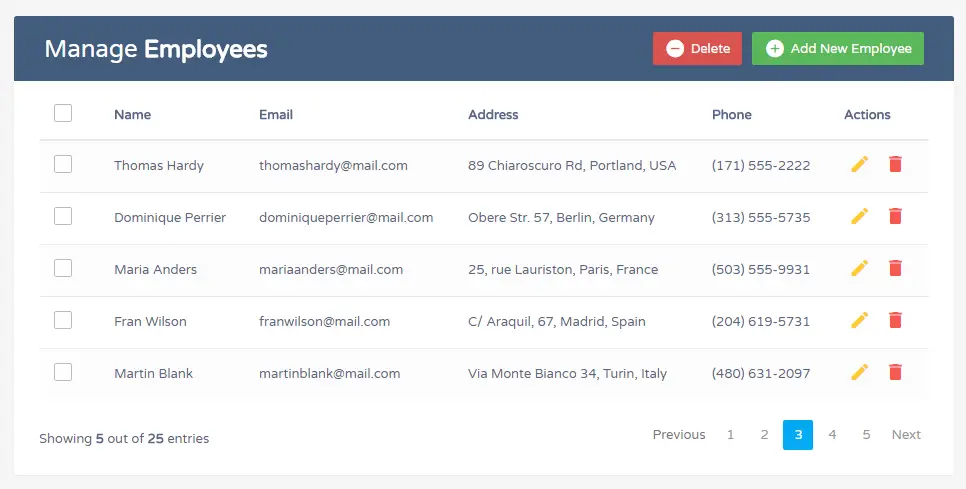In this tutorial you will learn about the Laravel Signature Pad Tutorial From Scratch and its application with practical example.
In this Laravel digital signature pad tutorial I’ll show you how to implement a digital signature pad in laravel. In this tutorial you will learn to implement a digital signature pad in laravel application. In this step by step guide I will demonstrate you how to implement a digital signature pad in laravel.
We will be using Laravel kenth-wood jquery UI signature pad library to implement digital signature pad in laravel application.
Laravel Signature Pad Tutorial From Scratch
- Step 1: Install Laravel New App
- Step 2: Connect Database To App
- Step 3: Create One Model and Migration
- Step 4: Add Routes For digital Signature Pad
- Step 5: Create Controller by Artisan Command
- Step 6: Create Blade View
- Step 7: Make Upload Directory
- Step 8: Start Development Server
Step 1: Install Laravel New App
First of all we need to create a fresh laravel project, download and install Laravel using the below command
|
1 |
composer create-project --prefer-dist laravel/laravel blog |
Step 2: Connect Database To App
Now, lets create a MySQL database and connect it with laravel application. After creating database we need to set database credential in application’s .env file.
|
1 2 3 4 5 6 |
DB_CONNECTION=mysql DB_HOST=127.0.0.1 DB_PORT=3306 DB_DATABASE=here your database name here DB_USERNAME=here database username here DB_PASSWORD=here database password here |
Step 3: Create Model and Migration
Now, in this step we will create model and migration file. Please run the following command:
|
1 |
php artisan make:model Signature -m |
Now, go to database/migrations directory and open create_signatures_table.php file in text editor. Then put the following code in your create_signatures_table.php file inside public directory.
|
1 2 3 4 5 6 7 8 9 10 11 12 13 14 15 16 17 18 19 20 21 22 23 24 25 26 27 28 29 30 31 32 33 |
<?php use Illuminate\Support\Facades\Schema; use Illuminate\Database\Schema\Blueprint; use Illuminate\Database\Migrations\Migration; class CreateSignaturesTable extends Migration { /** * Run the migrations. * * @return void */ public function up() { Schema::create('signatures', function (Blueprint $table) { $table->increments('id'); $table->string('name'); $table->string('signature'); $table->timestamps(); }); } /** * Reverse the migrations. * * @return void */ public function down() { Schema::dropIfExists('signatures'); } } |
Now, run the migration to create database table using following artisan command:
|
1 |
php artisan migrate |
Step 4: Add Routes For digital Signature Pad
After this, we need to define routes in “routes/web.php” file. Lets open “routes/web.php” file and add the following routes in it.
routes/web.php
|
1 2 |
Route::get('laravel-signature-pad','SignatureController@index'); Route::post('laravel-signature-pad','SignatureController@store'); |
Step 5: Create Controller by Artisan Command
Now, lets create a controller named SignatureController using command given below –
|
1 |
php artisan make:controller SignatureController |
Then, Navigate to app/http/controllers directory and open SignatureController.php file. And put following code into SignatureController.php file:
|
1 2 3 4 5 6 7 8 9 10 11 12 13 14 15 16 17 18 19 20 21 22 23 24 25 26 27 28 29 30 31 32 33 34 35 36 37 38 39 40 41 |
<?php namespace App\Http\Controllers; use Illuminate\Http\Request; use App\Signature; class SignatureController extends Controller { public function index() { return view('signature-pad'); } public function store(Request $request) { $folderPath = public_path('upload/'); $image_parts = explode(";base64,", $request->signed); $image_type_aux = explode("image/", $image_parts[0]); $image_type = $image_type_aux[1]; $image_base64 = base64_decode($image_parts[1]); $signature = uniqid() . '.'.$image_type; $file = $folderPath . $signature; file_put_contents($file, $image_base64); $save = new Signature; $save->name = $request->name; $save->signature = $signature $save->save(); return back()->with('success', 'Form successfully submitted with signature'); } } |
Step 6: Create a blade view
Now, we will create one blade view file that name signature-pad.blade.php file for digital signature pad. Then put the following code into your signature-pad.blade.php file:
|
1 2 3 4 5 6 7 8 9 10 11 12 13 14 15 16 17 18 19 20 21 22 23 24 25 26 27 28 29 30 31 32 33 34 35 36 37 38 39 40 41 42 43 44 45 46 47 48 49 50 51 52 53 54 55 56 57 58 59 60 61 62 63 64 65 |
<!DOCTYPE html> <html> <head> <title>Laravel 7 Signature Pad Tutorial From Scratch</title> <link rel="stylesheet" type="text/css" href="https://cdnjs.cloudflare.com/ajax/libs/twitter-bootstrap/4.3.1/css/bootstrap.css"> <script type="text/javascript" src="//ajax.googleapis.com/ajax/libs/jquery/1.12.4/jquery.min.js"></script> <link type="text/css" href="//ajax.googleapis.com/ajax/libs/jqueryui/1.12.1/themes/south-street/jquery-ui.css" rel="stylesheet"> <script type="text/javascript" src="//ajax.googleapis.com/ajax/libs/jqueryui/1.12.1/jquery-ui.min.js"></script> <style> .kbw-signature { width: 100%; height: 180px;} #signaturePad canvas{ width: 100% !important; height: auto; } </style> </head> <body class="bg-dark"> <div class="container"> <div class="row"> <div class="col-md-6 offset-md-3 mt-5"> <div class="card"> <div class="card-header"> <h5>Laravel 7 Signature Pad Tutorial From Scratch</h5> </div> <div class="card-body"> @if ($message = Session::get('success')) <div class="alert alert-success alert-dismissible"> <button type="button" class="close" data-dismiss="alert">×</button> <strong>{{ $message }}</strong> </div> @endif <form method="POST" action="{{ url('laravel-signature-pad') }}"> @csrf <div class="col-md-12"> <label class="" for="">Name:</label> <input type="text" name="name" class="form-group" value=""> </div> <div class="col-md-12"> <label class="" for="">Signature:</label> <br/> <div id="signaturePad" ></div> <br/> <button id="clear" class="btn btn-danger btn-sm">Clear Signature</button> <textarea id="signature64" name="signed" style="display: none"></textarea> </div> <br/> <button class="btn btn-success">Save</button> </form> </div> </div> </div> </div> </div> <script type="text/javascript" src="http://keith-wood.name/js/jquery.signature.js"></script> <link rel="stylesheet" type="text/css" href="http://keith-wood.name/css/jquery.signature.css"> <script type="text/javascript"> var signaturePad = $('#signaturePad').signature({syncField: '#signature64', syncFormat: 'PNG'}); $('#clear').click(function(e) { e.preventDefault(); signaturePad.signature('clear'); $("#signature64").val(''); }); </script> </body> </html> |
Step 7: Make Upload Directory
In this step, navigate to your laravel project root directory and open public directory. Inside public directory, create one new directory name upload.
Step 8: Start Development Server
Now we are ready to run our example so lets start the development server using following artisan command –
|
1 2 3 |
php artisan serve If you want to run the project diffrent port so use this below command php artisan serve --port=8080 |
Now, open the following URL in browser to see the output –
|
1 |
http://127.0.0.1:8000/laravel-signature-pad |

